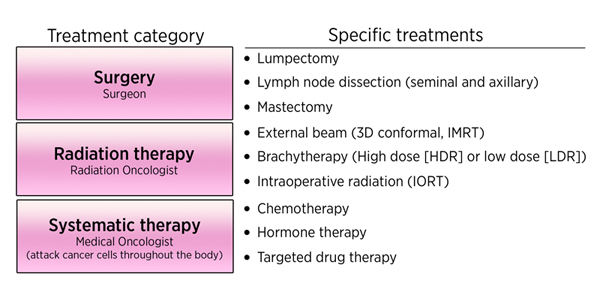
The last post in this series on breast cancer is on management. Of course, there is no universal treatment of ‘breast cancer’; everything is based on the specific type of breast cancer and the extent of progression upon diagnosis. Management usually involves a team approach in order to balance multiple considerations, which often leads to different treatment modalities being used together.
My goal today is to offer an understanding for the different components of treatment, not to get into the nuances of individual treatment regimens. I certainly recommend you engage your personal physician and resources such as the Center for Disease Control and Prevention and the American Cancer Society, which will provide you with any and all additional details you may desire.
Breast cancer is treated in several ways, including surgery, chemotherapy, hormonal therapy, biologic therapy, and radiation. Let’s review the basics of each.
- Surgery: Under certain circumstances, the cancer has only advanced to a level where it can be surgically removed. Surgical options include cutting out the area affected by the cancer (a lumpectomy), removing the entire breast (a mastectomy), and/or removing the areas where the cancer will drain and spread to other parts of the body (lymph node biopsy/resection). Of course, options aren’t actually quite this simple. Efforts to spare skin and tissue and to retain a cosmetic appearance are important considerations. Sometimes decisions to remove the other breast is made if the risk of breast cancer in that breast is sufficiently high. Additional surgical considerations include breast reconstruction after surgery, which may include one’s own tissue or a synthetic breast implant. These are options to be discussed with a plastic surgeon prior to breast cancer surgery.
- Chemotherapy: Chemotherapy is the use of medication to kill or reduce the cancer. Chemotherapy may be given via an IV (into the veins) or by pills. Chemotherapy may be given before surgery to reduce tumor size, after surgery or with other therapy to reduce the risk of recurrence, or as a primary treatment option.
- Radiotherapy (radiation therapy): High energy rays can be aimed at the cancer cells in an effort to kill them. Alternatively, radioactive material can be placed in the body.
- Hormonal therapy: As mentioned in this post, certain cancer cells are stimulated by hormones to grow. Hormonal therapy blocks cancer cells from getting the specific hormones that assist growth. Different drugs in this class act in a variety of different ways, both direct and indirect, with the same end result of diminishing the ability of hormones to stimulate tumor growth. Yes, this treatment option would be better named hormonal blocking therapy. Hormonal therapy also can be used as a primary treatment option or after other treatment options to reduce the chance of recurrence.
- Biological therapy: Biological therapy serves to boost the body’s immune system to better help it fight the cancer. It also is of assistance in addressing immune-reducing side effects other cancer treatments may create.
- Targeted drugs: An additional treatment modality is the use of targeted drugs, which attack specific abnormalities within cancer cells. The most notable example of such an abnormality is the presence of a human growth factor receptor 2 (HER2), a protein that helps breast cancer cells grow and survive..
Complications and side effects of breast cancer treatment are plentiful, and they vary based on the treatment given. Surgery carries a risk of bleeding and infection. Risks of radiation therapy include fatigue and a red, sunburn-like rash where the radiation is aimed. Breast tissue may be altered in texture and may appear swollen. Rarely, damage to the heart or lungs may occur. Common side effects of chemotherapy include hair loss, nausea, vomiting, fatigue and an increased risk of developing infection. Rare side effects can include premature menopause, damage to the heart and kidneys, nerve damage, and, very rarely, blood cell cancer.
The teams of medical, radiological and surgical cancer specialists who treat breast and other cancers do phenomenal work. Do your part in reducing your risks and engaging in practices (breast self-exam and mammograms) that allow for early detection. Remember, the days of increasing rates of breast cancer are behind us, and breast cancer survivors abound, with approximately 2.8 million survivors in the US. You now have the tools to be included in those numbers should (heaven forbid) you find yourself afflicted by breast cancer.
I welcome your questions and comments.
Copyright © 2013 · Sterling Initiatives, LLC · Powered by WordPress
